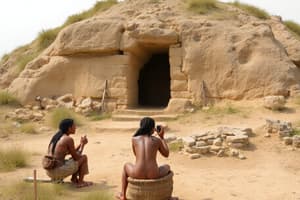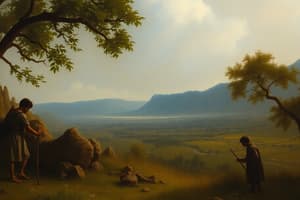Podcast
Questions and Answers
Based on the map and information provided, what was the MOST likely primary factor influencing the location of hunter-gatherer sites?
Based on the map and information provided, what was the MOST likely primary factor influencing the location of hunter-gatherer sites?
- Access to reliable water sources. (correct)
- Strategic elevation for defense against predators.
- Proximity to religious centers.
- Availability of diverse plant species.
Why was the availability of good quality stone a significant factor for early humans?
Why was the availability of good quality stone a significant factor for early humans?
- Stone was used for creating decorative art and jewelry.
- Stone was used for constructing permanent housing structures.
- Stone tools were essential for hunting and daily tasks. (correct)
- Stone was a valuable trade commodity with other settlements.
The rock shelters of Bhimbetka provide insight into early human life. Besides shelter, what other crucial advantage did these locations offer to those early inhabitants?
The rock shelters of Bhimbetka provide insight into early human life. Besides shelter, what other crucial advantage did these locations offer to those early inhabitants?
- Proximity to migration routes of large game animals.
- Natural defense against rival groups.
- Access to the Narmada Valley. (correct)
- Fertile land suitable for agriculture.
If archaeologists discovered a new site with numerous rock paintings depicting detailed hunting scenes, what inferences could they reasonably make about the people who created them?
If archaeologists discovered a new site with numerous rock paintings depicting detailed hunting scenes, what inferences could they reasonably make about the people who created them?
How do the archaeological sites mentioned contribute to our broader understanding of early human societies?
How do the archaeological sites mentioned contribute to our broader understanding of early human societies?
Hunter-gatherer societies often moved from place to place. Which of the following is the LEAST likely reason for these movements?
Hunter-gatherer societies often moved from place to place. Which of the following is the LEAST likely reason for these movements?
Archaeological evidence suggests that early tools were made from stone, wood, and bone. Why are stone tools the most commonly found artifacts from hunter-gatherer societies?
Archaeological evidence suggests that early tools were made from stone, wood, and bone. Why are stone tools the most commonly found artifacts from hunter-gatherer societies?
A group of archaeologists discovers a site with numerous stone tools, including scrapers and choppers. What can they infer about the activities of the people who lived there?
A group of archaeologists discovers a site with numerous stone tools, including scrapers and choppers. What can they infer about the activities of the people who lived there?
How did the availability of water sources influence the settlement patterns of early hunter-gatherer communities?
How did the availability of water sources influence the settlement patterns of early hunter-gatherer communities?
Based on the tools discovered and the materials they were made from, which activity would be LEAST supported by archaeological evidence from hunter-gatherer sites?
Based on the tools discovered and the materials they were made from, which activity would be LEAST supported by archaeological evidence from hunter-gatherer sites?
Flashcards
Seasonal Movement
Seasonal Movement
People moved to find plants in season.
Perennial Water Sources
Perennial Water Sources
Rivers or lakes with water year-round.
Archaeological Finds
Archaeological Finds
Objects made and used by hunter-gatherers.
Durable Tools
Durable Tools
Signup and view all the flashcards
Stone Tool Uses
Stone Tool Uses
Signup and view all the flashcards
Archaeological Sites (Hunter-Gatherers)
Archaeological Sites (Hunter-Gatherers)
Signup and view all the flashcards
Bhimbetka
Bhimbetka
Signup and view all the flashcards
Rock Paintings
Rock Paintings
Signup and view all the flashcards
Narmada Valley
Narmada Valley
Signup and view all the flashcards
Stone tool importance
Stone tool importance
Signup and view all the flashcards
Study Notes
- Tushar was traveling from Delhi to Chennai by train for his cousin's wedding.
- About 2 million years ago, people lived in the subcontinent and are described as hunter-gatherers based on how they obtained food
- Hunter-gatherers generally hunted wild animals, and caught fish and birds
- They gathered fruits, roots, nuts, seeds, leaves, stalks and eggs
Reasons for Movement
- Hunter-gatherers moved from place to place for several reasons
- To find food, they had to move to new locations when the available plant and animal resources were depleted
- Animals move in search of smaller prey or for grass and leaves
- People may have moved according to the seasons to find different kinds of plants
- People, plants, and animals need water, so they would move to find water during dry seasons
How We Know About These People
- Archaeologists have found tools of stone, wood, & bone made and used by hunter-gatherers
- Stone tools survived best
- Stone tools were used to cut meat, bone, scrape bark, chop fruits and roots, and make spears and arrows for hunting
- People used other tools to chop wood for firewood, and also for huts and tools
- Stone tools aided in digging the ground for edible roots and stitching clothes
Choosing a Place to Live In
- Archaeological sites with evidence of hunter-gatherers are marked with red triangles on maps
- These sites were located near sources of water
Rock Paintings
- Early people lived in caves and created paintings on the walls
- Examples from Madhya Pradesh and Uttar Pradesh show wild animals, drawn with skill
Sites
- Sites are places where remains of tools, pots, and buildings were found
- These items were made, used, and left behind by people
- Sites can be found on the surface, buried, or underwater
Discovering Fire
- Traces of ash found in the Kurnool caves suggest people were familiar with fire
- Fire could have been used as a source of light, to roast meat, and to scare away animals
Names and Dates
- The earliest period is called the Paleolithic, which extends from 2 million years ago to 12,000 years ago
- The term comes from the Greek words 'palaeo' (old) and 'lithos' (stone)
- The Paleolithic period is divided into the Lower, Middle, and Upper Paleolithic and covers 99% of human history
- The Mesolithic period, marked by environmental changes, lasted from 12,000 to 10,000 years ago
- Stone tools from this period are called microliths
- Microliths were attached to handles of bone or wood to make tools like saws and sickles, while older tool types remained common
- The Neolithic stage began about 10,000 years ago
A Changing Environment
- About 12,000 years ago, major climate changes led to warmer conditions, resulting in grasslands
- The number of deer, antelope, goat, sheep, and cattle increased
- People followed these animals, learned about their habits, and began herding them
- Fishing became another important activity as well
The Beginning of Farming and Herding
- Wheat, barley, and rice began to grow naturally in different parts of the subcontinent
- Men, women, and children gathered grains for food, leading to the development of farming
- People attracted and tamed animals by leaving food near their shelters
- The first animal to be tamed was the wild ancestor of the dog
- People then encouraged gentle animals like sheep, goat, cattle, and pig to come near the camps, protecting them and herding them
Domestication
- Domestication is the process of growing plants and looking after animals
- Domesticated plants and animals differ from wild ones because people select plants and animals that are not prone to disease
- People selected plants with large-size grain and strong stalks, and animals that are gentle, leading to gradual changes
- Domestication began about 12,000 years ago
- Some of the earliest plants and animals to be domesticated were wheat, barley, sheep, and goat
A New Way of Life
- Growing plants requires staying in one place for a long time to look after them until the grain ripens
Storing Food
- Because grain needed storing, people created clay pots, wove baskets, and dug pits
Rearing Animals
- Animals multiply naturally, provide milk, and meat
- Reared animals are a store of food
The First Herders
- Archaeologists found evidence of early farmers and herders marked by blue squares on the map
- Evidence is found all over the subcontinent, including north-west, Kashmir, and east & south India
- Scientists study plants and animal bones from these sites
- Burnt grain remains help identify the crops that were grown
- Scientists can also identify the bones of different animals
Towards a Settled Life
- Archaeologists found huts or houses at some sites such as pit-houses in Burzahom
- Pit-houses dug into the ground with steps suggest shelter in cold weather
- Hearths found inside and outside the huts suggest people could cook indoors or outdoors depending on the weather
- Stone tools from many sites included Neolithic tools.
- Neolithic tools were polished to give a fine cutting edge
- Mortars and pestles used for grinding grain are still used today
- Pots were sometimes decorated and used for storage.
- People began using pots for cooking food, especially grains
Living and Dying in Mehrgarh
- Mehrgarh is located in a fertile plain near the Bolan Pass, an important route into Iran
- It is one of the earliest villages where people grew barley and wheat, and raised sheep and goats
- Bones of wild animals such as deer and pig, and also domesticated animals were found
- Houses were square or rectangular and had four or more compartments for storage
- People generally pay respect by burying their dead
- Burial sites have been found at Mehrgarh, with the dead buried with goats for food in the next world
Studying That Suits You
Use AI to generate personalized quizzes and flashcards to suit your learning preferences.




